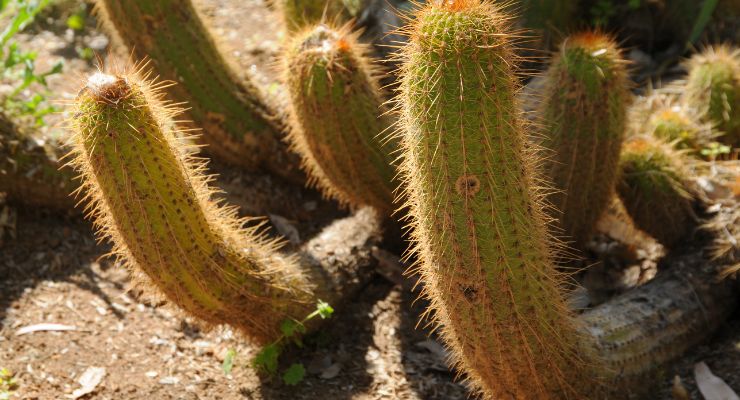Cacti are known for their hardy and resilient nature, but they can still be susceptible to certain problems, including brown spots on their surface. These spots may appear as small or large discolorations on the cactus, and they can be a sign of a variety of different problems.
Some of the most common causes of brown spots on cacti include sunburn, pests, diseases, and improper watering. Understanding the underlying cause of the brown spots is important in determining the best course of action to address the issue and prevent further damage to the cactus.
Now, we will explore some of the possible causes of brown spots on cacti and suggest some solutions for treating and preventing this issue.
Identifying Brown Spots on Cactus Plant
Brown spots on cacti can take on various forms, and their appearance can vary depending on the cause of the spots. Some common physical characteristics of brown spots on cacti include:
Small or large discolored spots on the surface of the cactus
Irregular shapes, ranging from circular to oblong or angular
Dull or dark brown in color
May appear raised or sunken
May be accompanied by other symptoms, such as wilting or softening of the affected area
Causes of Brown Spots on Cactus
Excess Sun Exposure
One of the most common causes of brown spots on cacti is exposure to excessive sunlight. This is especially true during the hot summer months when the sun’s rays can be intense and damaging to cacti plants. Here are two ways to address this issue:
If the cactus is currently situated in a location where it receives too much sun, moving it indoors can help protect it from the sun’s rays. However, it is important to ensure that the indoor location still provides sufficient light for the cactus to thrive.
If it is not possible to move the cactus indoors, providing additional shade can help protect it from the sun’s rays. This can be done by using shade cloth, placing the cactus under a shade tree or other shaded area, or creating a makeshift shade structure using materials such as fabric or cardboard. It is important to ensure that the shade structure does not block too much light, as cacti still require adequate sunlight to grow and thrive.
Improper Watering
Overwatering or underwatering can also cause brown spots on cacti. This can occur when the cactus is not receiving the proper amount of water for its specific needs.
Before watering the cactus, it is important to check the moisture level of the soil. Inserting a finger or moisture meter into the soil can help determine if the soil is too wet, too dry, or just right. Cacti generally prefer soil that is slightly dry, as overwatering can lead to root rot and other problems.
It is also important to ensure that the soil has adequate drainage, as waterlogged soil can also cause brown spots on cacti. Adjusting the watering schedule and amount based on the cactus’ specific needs can help prevent brown spots caused by improper watering.
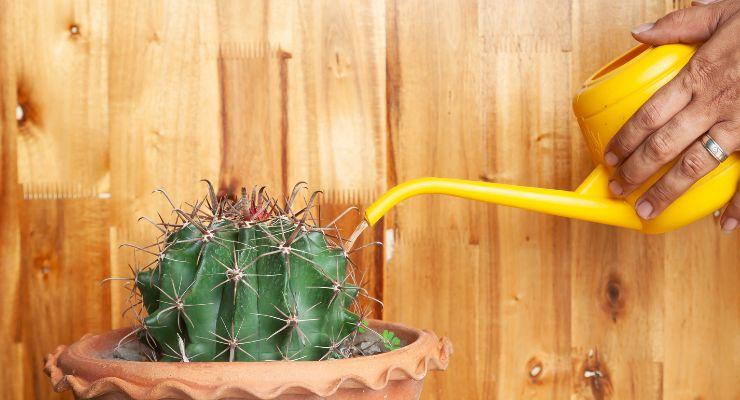
Temperature Stress
Cacti are adapted to thrive in hot and arid environments, but they can also be sensitive to temperature fluctuations. Exposure to extreme temperatures, whether hot or cold, can cause brown spots on cacti plants.
If the cactus is situated in an area with extreme temperatures, such as near a window or air conditioning unit, relocating the pot to a more temperature-stable area can help prevent brown spots. This can be a shaded area outdoors or an indoor location with stable temperatures.
In cold weather, providing insulation around the cactus can help protect it from extreme temperatures. This can be done by placing a protective cover or blanket around the cactus or moving it to a warmer location, such as indoors or in a greenhouse.
It is important to ensure that the cactus is not exposed to sudden temperature changes, which can also cause brown spots.
Pest Infestation
Pests such as mealybugs, spider mites, and scale insects can also cause brown spots on cacti. These pests can damage the cactus by feeding on its sap and causing discoloration or scarring on the whole plant tissue.
Regularly inspecting the cactus for signs of pests can help prevent and address infestations. Look for visible pests, such as webbing or small insects, as well as signs of damage such as yellowing, wilting, or brown spots.
If pests are detected, treating the cactus with an appropriate pesticide or insecticidal soap can help control the infestation. It is important to follow instructions carefully and avoid using harsh chemicals that can damage the cactus or harm beneficial insects.
Fungal Disease
Fungal diseases can also cause brown spots on cacti plants, particularly in humid conditions. These diseases can spread quickly and cause significant damage to the cactus. Solutions:
Discarding Infected Portions
If only a portion of the cactus plant is infected, removing and discarding the infected portion can help prevent the spread of the disease. Use a clean, sharp tool to make the cut, and ensure that the tool is disinfected before and after use.
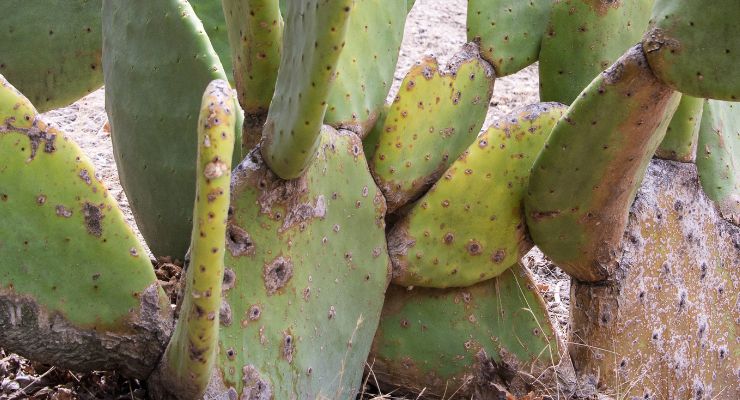
Applying Fungicide
Applying a fungicide to the cactus can help prevent and treat fungal diseases. Choose a fungicide that is safe for cacti and follow the instructions carefully. It is important to avoid over-application, as this can damage the cactus.
Avoiding Humid Conditions
Fungal diseases thrive in humid conditions, so avoiding high humidity can help prevent the onset of fungal disease. Providing adequate air circulation around the cactus, avoiding overwatering (with this root rot), and ensuring that the cactus is not placed in a damp or humid location can all help prevent fungal diseases and the resulting brown spots.
Fertilizer Overdose
Over-fertilization can also cause cactus brown spots. Fertilizers contain high levels of nutrients that can damage the roots and cause brown spots on the cactus. Here are two ways to address this issue:
Leaching or Rinsing Off Excess Fertilizer
If the cactus has been over-fertilized, leaching or rinsing off excess fertilizer can help reduce the levels of nutrients in the soil. This can be done by flushing the soil with water until the excess fertilizer is removed or by gently rinsing the soil off the roots of the cactus.
Repotting in Fresh Soil if Necessary
If the cactus is severely over-fertilized or has been growing in the same soil for an extended period, fresh potting soil can help prevent further damage and promote healthy new growth again.
Use a well-draining soil mix that is appropriate for cacti and ensure that the pot has adequate drainage to prevent over-fertilization in the future.
Inadequate Air Circulation
Poor air circulation can also contribute to the development of brown spots on cacti. When air does not circulate properly around the plant, moisture can build up and create a favorable environment for pests and diseases. Pests, like red spider mites, infect cacti by sucking on plant tissues.
Allowing fresh air to circulate around the cactus can help prevent the buildup of moisture and promote healthy growth. Opening windows and doors or moving the cactus to a location with better airflow can help address this issue.
Exhaust fans can help promote air circulation and reduce humidity levels in areas where air does not circulate well. Installing an exhaust fan in the room where the cactus is located or using a portable fan to promote air circulation can help prevent the development of brown spots on cacti.
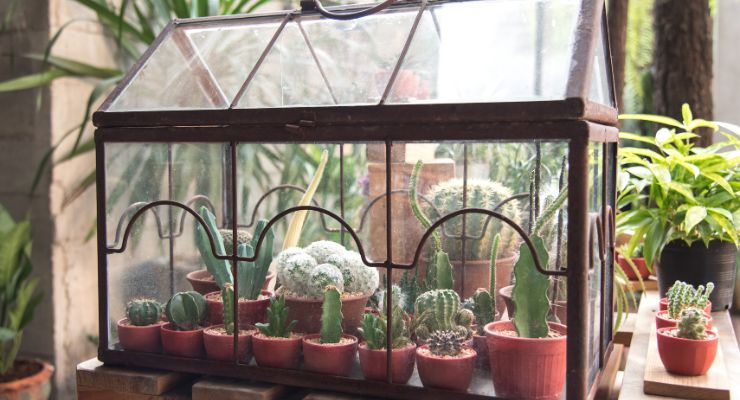
High Humidity
High humidity can contribute to the development of brown spots on cacti, particularly if the humidity is prolonged and persistent. When the air around the cactus is humid, moisture can build up on the surface of the plant, creating an environment that is conducive to fungal growth and pest infestations.
As mentioned earlier, providing adequate air circulation around the cactus can help reduce humidity levels and prevent the development of brown spots. This can be done by opening windows and doors, using exhaust fans, or moving the cactus to a location with better airflow.
Overwatering can contribute to high humidity levels by creating a damp environment around the cactus. To prevent overwatering and root rot, check the soil moisture regularly and water the cactus only when the soil is dry to the touch. Ensure that the pot has adequate drainage to prevent water from accumulating in the soil.
If the humidity in the room where the cactus is located is consistently high, using a dehumidifier can help reduce humidity levels and prevent the development of brown spots.
Monitoring humidity levels in the room where the cactus plant is located can help prevent the onset of high humidity. A humidity gauge or hygrometer can be used to measure humidity levels and ensure that they remain within the appropriate range for cactus plants.
Frost Damage
Exposure to frost can cause brown spots on cactus plants, particularly if the frost is prolonged or severe. When cacti are exposed to frost, ice crystals can form on the surface of the plant, damaging the cells and causing brown spots to develop.
Relocating Cactus plants During Cold Nights
During cold nights or frost warnings, relocating cactus plants indoors or to a warmer location can help prevent frost damage. Cacti are sensitive to extreme temperatures, and exposure to frost can be damaging.
Protecting Cactus Plants from Frost
Covering the cactus with a protective material, such as a blanket or tarp, can help prevent frost damage and dying cactus. The covering should be removed during the day to allow for adequate airflow and direct sunlight.
Warming Area with Lighting
Using lighting, such as heat lamps or string lights, can help warm the area around the cactus and prevent frost damage. This can be particularly useful in areas with consistently low temperatures or where frost is a common occurrence. However, it is important to ensure the lighting does not overheat or burn the cactus.
Preventing Brown Spots on Cactus
Preventing brown spots on cactus plants is easier than treating them. Here are some tips to help prevent the brown cactus spots from developing:
Provide Adequate Sunlight
Water Cacti Properly
Ensure Adequate Air Circulation
Monitor for Pests and Diseases
Protect Cacti from Frost
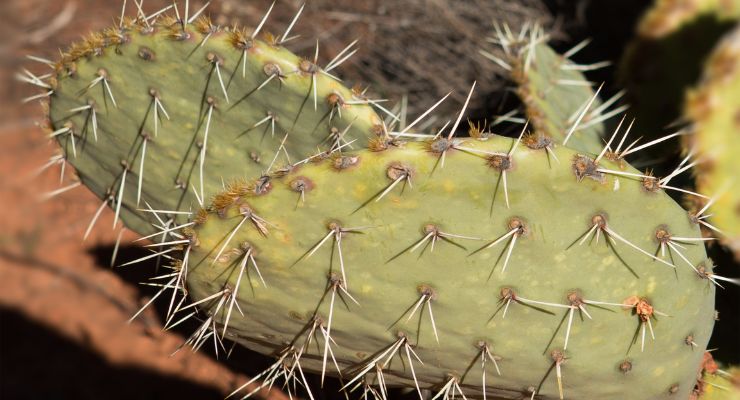
Treatment of Brown Spots on Cactus
If brown spots have already developed on a cactus, prompt treatment is necessary to prevent further damage and promote the plant’s recovery.
The first step in treating brown spots on cacti is to identify the cause of the spots. This will help determine the most effective treatment option.
Remove Infected Portions
If the brown spots are caused by fungal infections or pest infestations, removing the infected portions of the cactus can help prevent the spread of the infection. Infected portions should be cut away using a clean, sharp knife or pruning shears.
Apply Fungicide
If the brown spots are caused by fungal infections, applying a fungicide can help prevent the spread of the infection. Fungicides can be purchased at most garden centers and should be applied according to the manufacturer’s instructions.
Rinse or Leach Excess Fertilizer
If the brown spots are caused by fertilizer overdose, rinsing or leaching the excess fertilizer out of the soil can help reduce the amount of fertilizer in the soil and prevent further damage.
Adjust Watering Schedule
If the brown spots are caused by overwatering or underwatering, adjusting the watering schedule to provide the appropriate amount of moisture can help promote recovery.
Relocate Cactus
If the brown spots are caused by temperature stress, relocating the cactus to a more suitable location can help promote recovery.
Monitor Progress
After treatment, monitor the cactus for signs of improvement. Depending on the cause and severity of the brown spots, it may take some time for the plant to recover fully.
By following these treatment options, cacti owners can help restore their plants to health and prevent further damage from brown spots.
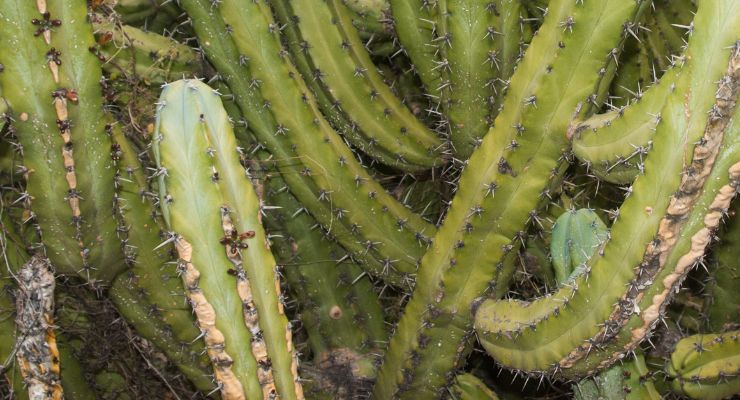
FAQs
Are brown spots on cacti harmful to the plant’s health?
Brown spots on cacti can be harmful to the plant’s health and appearance. It is important to identify and address the cause promptly to prevent further damage. By taking appropriate measures, cacti owners can help ensure the health and longevity of their plants.
Are all types of cacti susceptible to brown spots?
Most types of cacti can be susceptible to brown spots. However, some cactus species may be more resilient in turning brown than others and may be better adapted to tolerate certain environmental conditions.
It is important to research the specific needs and requirements of the type of cactus you are growing to help prevent brown spots and other issues.
How quickly can brown spots spread on a cactus?
The speed at which brown spots can spread on a cactus depends on the underlying cause and the health of the entire plant itself.
It is important to identify and address the cause turn brown, promptly to prevent further damage and potential spread to other parts of the cactus. Regular monitoring and maintenance can help catch and address brown spots early.
Conclusion
Proactive care is crucial for the health and longevity of cacti. By identifying and addressing issues such as brown spots promptly, cacti owners can help prevent further damage and ensure that their plants thrive.
If you own cacti, it is important to research the specific needs and requirements of your plants, including their lighting, watering, and temperature needs. Regularly monitoring your plants for signs of brown spots and other issues can help catch and address problems early. By providing proper care and attention, you can help your cacti thrive and enjoy their unique beauty for years to come.
